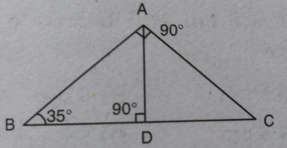IF B={1,7,2,0,6} then n(B)=……….Solution in Telugu
7
0
6
5
The correct Answer is:D
Step by step video, text & image solution for IF B={1,7,2,0,6} then n(B)=………. by Maths experts to help you in doubts & scoring excellent marks in Class 10 exams.
Updated on:21/07/2023Topper's Solved these Questions
- SETS BOOK - VGS PUBLICATION-BRILLIANTCHAPTER - SETS EXERCISE - OBSERVATION BITS TO SOLVE VARIOUS QUESTION GIVEN IN THE PUBLIC EXAMINATION
21 Videos
- REAL NUMBERS (MULTIPLE CHOICE QUESTION)BOOK - VGS PUBLICATION-BRILLIANTCHAPTER - REAL NUMBERS (MULTIPLE CHOICE QUESTION)EXERCISE - REAL NUMBERS (MULTIPLE CHOICE QUESTION)
22 Videos
- SIMILAR TRIANGLES BOOK - VGS PUBLICATION-BRILLIANTCHAPTER - SIMILAR TRIANGLES EXERCISE - CREATIVE BITS FOR CCE MODEL EXAMINATION
90 Videos
Similar Questions
Set of human being that reside on moon is ………………..
View Solution915=…………..
View SolutionFrom the figure ,∠DAC……….

View SolutionIf A and B are square matrices of the same order such that AB=BA, then proveby induction that ABn=BnA. Further, prove that (AB)n=AnBnfor all n∈N.
View SolutionIf A and B are two disjoint sets, then n(A∪B) is equal to n(A)+n(B) b. n(A)+n(B)−n(A∩B) c. n(A)+n(B)+n(A∩B) d. n(A)n(B)
View Solutiona-b divides an−bn,n∈N
View Solutionसत्य - असत्य n(A∪B)=n(A)+n(B)+n(A∩B)
View SolutionAssertion: If a and b are distinct integers then (a - b) is a factor of an−bn:
Reason(R): an=[(a−b)+b]n
View SolutionIF B={1,7,2,0,6} then n(B)=……….
View Solutionn(A) = 300, n(A∪B) = 500, n(A∩B) = 50 மற்றும் n(B′) = 350, n(B) மற்றும் n(U) காண்க ?
View SolutionLet A,B be two matrices such that they commute, then for any positive integer n,
(i) ABn=BnA
(ii)(AB)n=AnBn
View SolutionIf A and B are square matrices of the same order such that AB=BA, then proveby induction that ABn=BnA. Further, prove that (AB)n=AnBnfor all n∈N.
View SolutionIf A and B are two disjoint sets, then n(AuB) is equal to a.n(A)+n(B) b. n(A)+n(B)−n(AnB) c. n(A)+n(B)+n(AnB) d. n(A)n(B)
View SolutionFor sets A and B, n(A−B)=8+2x,n(B−A)=6x and n(A∩B)=x. If n(A)=n(B) then n(A∩B)=………..
View SolutionIf n(A∪B)=50, n(A)=31 and n(B)=23, find n(A∩B), n(A−B) and n(B−A)
View Solution
